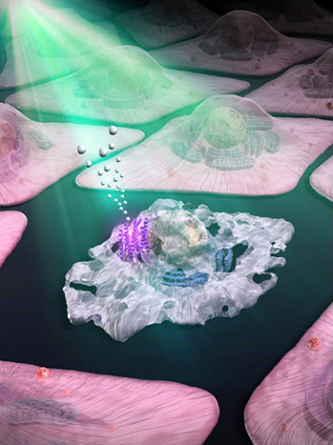Researchers at Okayama University in Japan developed a novel technique to induce cancer cell apoptosis using light. The technology involves modifying the cells to express a light-sensitive protein that rapidly pumps hydrogen ions out of the cell when it is stimulated with light. This increase in cell alkalinity causes it to undergo apoptosis, a form of programmed cell death. The researchers hope that the technology could pave the way for cancer therapies that are more gentle than current treatments, which often result in cell necrosis, a more traumatic form of cell death.
Technologies that target cancer have been in development for a long time and decades of research have borne fruit in the form of improved patient survival. However, many treatments cause unacceptable side effects, and a significant portion of modern cancer research is dedicated to developing approaches that both improve efficacy and reduce off-target effects.
Part of the issue is the way in which many therapies induce cancer cell death through necrosis. This involves inducing catastrophic damage to a cell, which then dies soon after. Not only does inducing this form of traumatic cell death increase the chance of side effects, but it is difficult to make it less intrusive for nearby healthy cells.
“These methods use chemical substances and cause necrosis physically by relying on active enzymes or heat,” said Yuki Sudo, a researcher involved in the latest study. “Thus, we cannot eliminate adverse reactions no matter how much we improve them.”
Instead, these researchers have created a system which can reliably induce cell death through apoptosis, which can be described as closer to a ‘natural’ cell death. The process involves a biochemical cascade that kills the cell, and the body uses this process to naturally rid itself of unhealthy cells or to sculpt tissues during development. “We thought that if we could stealthily induce apoptosis in the target cancer cells using proteins rather than chemicals, we could help realize a breakthrough in cancer treatment without the accompanying side effects,” said Sudo.

This new technology involves inducing cancer cells to express archaerhodopsin-3 (AR3), a light-sensitive protein that pumps hydrogen ions out of cells when it is exposed to light. The resulting shift in the cell pH causes it to induce apoptosis, potentially providing a more gentle way to produce cell death.
So far, the researchers have tested the technique in cancer cells and nematode worms that express AR3, and showed that they undergo apoptosis when they exposed them to green light. The next steps involve trying the technique in more complex animals, such as rodents.
Study in Journal of the American Chemical Society: Phototriggered Apoptotic Cell Death (PTA) Using the Light-Driven Outward Proton Pump Rhodopsin Archaerhodopsin-3
Via: Okayama University other Science Japan
